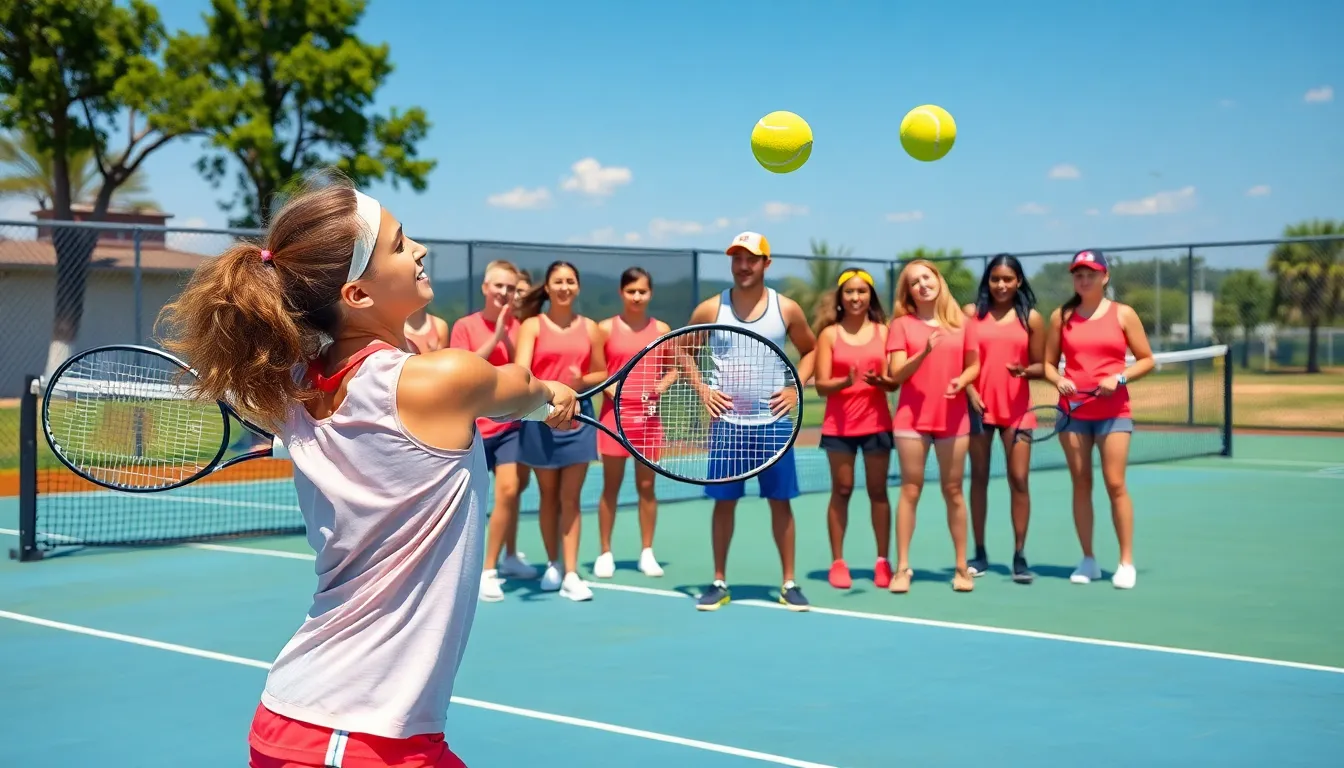Wondering what you do in a tennis team? Beyond just hitting fuzzy yellow balls across the net, being part of a tennis team offers a unique blend of individual achievement and team camaraderie that few sports can match.
When you join a tennis team, you’ll participate in both singles and doubles matches, attend regular practices to hone your skills, and represent your school, club, or community in competitions. You’ll develop not only technical abilities like serves and volleys but also mental toughness and strategic thinking. The experience combines personal growth with the support system of teammates who share your passion for the game.
Understanding High School and College Tennis Team Structure
High School Tennis Team Organization
High school tennis teams operate with a ladder ranking system that determines player positions. Each school typically fields 6-7 singles players and 3 doubles teams for competitions. During my years coaching at Florida high schools, I’ve seen how this structure creates both healthy internal competition and team unity.
The tennis season runs differently based on your location—fall seasons are common in warmer states like Florida, while spring seasons prevail in cooler regions. Most high school teams practice 4-5 days weekly, with matches scheduled 1-3 times per week against local schools.
Team captains play crucial roles as liaisons between coaches and players. They lead warm-ups, motivate teammates, and organize team bonding activities. Your position on the team ladder isn’t permanent—challenge matches allow you to move up by defeating players ranked above you.
College Tennis Team Dynamics
College tennis intensifies the competitive structure with more formalized ranking systems. NCAA Division I teams typically have 8-10 players, while Division III programs might carry 12-14 players to accommodate more developmental athletes.
The dual match format in college features 6 singles and 3 doubles matches. Teams earn a point by winning 2 of 3 doubles matches, followed by individual points for each singles victory. This scoring system creates exciting scenarios where every match contributes to the team outcome.
College tennis demands important time commitment—20 hours weekly during season and 8 hours during off-season periods. Your schedule includes morning strength training, afternoon practices, weekend competitions, and mandatory study halls.
Differences Between High School and College Tennis
College tennis introduces several key differences from high school competition. The no-ad scoring system eliminates traditional advantage scoring—at deuce, the next point determines the game winner. This format creates high-pressure points and faster matches.
Equipment standards increase dramatically at the collegiate level. While high school players often use diverse racquet brands, college programs frequently secure team sponsorships providing uniform equipment. One Division I program I worked with had a full Babolat sponsorship that provided identical racquets, strings, and bags for consistency.
The coaching approach evolves significantly from high school to college. High school coaches often focus on fundamentals and team building, while college coaches carry out sophisticated game strategy and detailed performance analytics. College programs employ assistant coaches, strength trainers, and sometimes sports psychologists to develop players’ complete athletic profiles.
Competition scheduling also differs substantially. High school teams typically compete within their district or region, while college teams travel extensively for tournaments and dual matches. Your commitment expands from local after-school matches to weekend tournaments requiring overnight travel across multiple states.
Tennis Team Tryouts and Selection Process
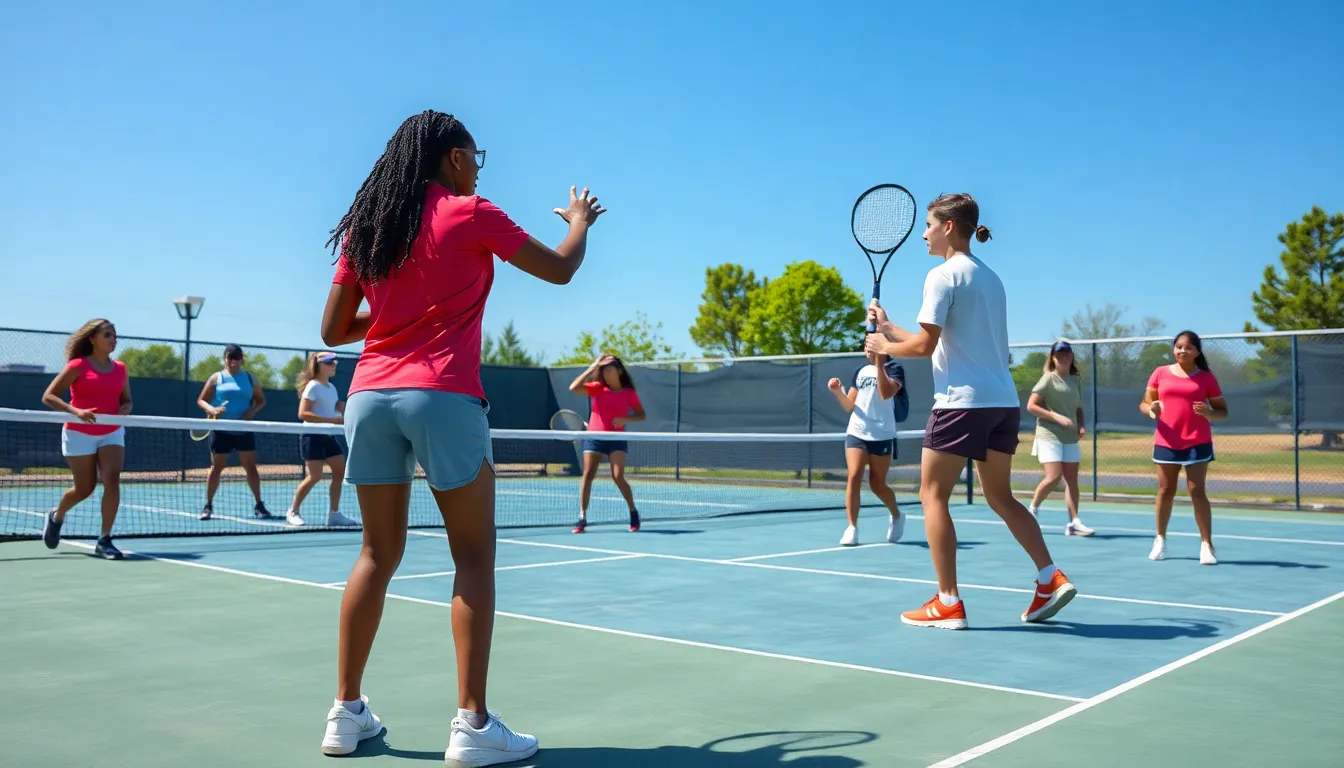
Tennis team tryouts establish player rankings and determine team composition through structured evaluation processes. Coaches use exact methods to assess skills, create hierarchies, and build competitive lineups for both varsity and junior varsity teams.
Skill Assessment and Ranking
Skill assessment forms the backbone of tennis team selection, using pro-sets and round robin tournaments to evaluate players. Coaches typically group participants by ability level during tryouts, conducting one-set matches that reveal technical proficiency, competitive spirit, and tactical awareness. The evaluation extends beyond basic shot skills to include reaction time, agility, endurance, and footwork—all crucial components of a well-rounded tennis player.
Official tennis ratings like UTR (Universal Tennis Rating) and NTRP (National Tennis Rating Program) provide additional objective measures during the selection process. These standardized metrics help coaches make informed decisions when comparing players with similar on-court performances. Past records and previous competitive successes also factor into team selection, offering insights into a player’s consistency and mental fortitude under pressure.
Once initial assessments are complete, players earn their positions on a team ladder or ranking system. This hierarchical structure isn’t permanent—it remains ever-changing throughout the season as players can challenge those ranked above them based on ongoing performance improvements.
Competitive Challenges
Challenge matches drive continuous improvement within tennis teams by allowing players to contest their current rankings. These internal competitions create a merit-based environment where your position on the team reflects your present skill level rather than past accomplishments. The challenge system typically follows exact protocols, with players able to challenge teammates ranked 1-2 positions above their current standing.
Preseason matches serve as valuable evaluation tools before official competition begins. These preliminary contests help coaches refine lineups, observe players in authentic competitive settings, and make final adjustments to both singles and doubles pairings. Throughout this process, coaches emphasize more than just technical ability—they assess sportsmanship, commitment to training, physical conditioning, and understanding of team roles.
Ladder matches during the regular season maintain competitive intensity and ensure that team rankings accurately reflect current capabilities. This ongoing internal competition benefits the entire team by pushing everyone to maintain peak performance levels. The challenge structure creates opportunities for growth while fostering healthy competition among teammates who share common goals of individual improvement and team success.
Regular Practice Sessions and Training
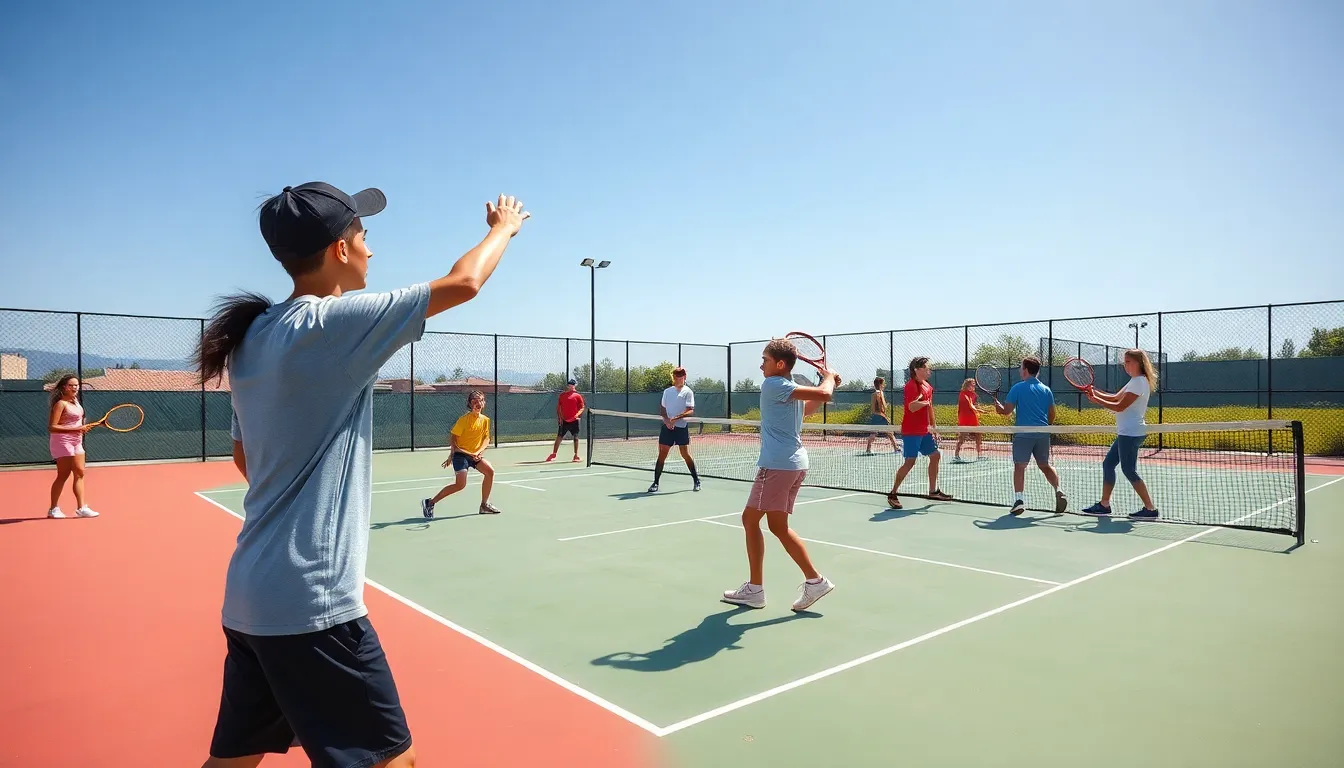
Tennis team practice sessions form the foundation of player development and team success. You’ll participate in frequent, structured training that builds both individual skills and team cohesion through targeted drills and simulated match scenarios.
Technical Skill Development
Technical skill development occupies a central place in tennis team practices. You’ll work on refining stroke mechanics through specialized drills focusing on serves, returns, volleys, and groundstrokes. Coaches carry out progressive training exercises that break down complex movements into manageable components, allowing you to master each element before combining them into complete strokes.
“When I coach my college teams, we dedicate at least 30 minutes of each practice to isolated stroke development,” explains Azura Victoria, founder of tennisservetypes.com. “This focused approach helps players identify weaknesses and transform them into strengths over time.”
Doubles strategy receives particular attention during team practices. You’ll learn exact court positioning, communication techniques, and tactical approaches like poaching that optimize teamwork. Practice sessions often include scenarios where you rotate through different roles—server, net player, and returner—to understand the responsibilities of each position. This comprehensive approach ensures you develop a complete tennis skill set rather than excelling in just one area.
Physical Conditioning for Tennis
Physical conditioning programs in tennis teams target the exact demands of match play. You’ll engage in strength training exercises that build power for explosive shots while developing the muscular endurance needed for lengthy matches. Cardiovascular fitness remains equally important, with interval training that mimics the start-stop nature of tennis points.
Your conditioning regimen will include:
- Agility drills to improve quick direction changes
- Flexibility exercises to prevent injuries and increase range of motion
- Coordination training for precise shot execution
- Tennis-exact movement patterns that enhance court coverage
“I’ve found that integrating tennis-exact movements into conditioning routines produces far better results than generic fitness programs,” notes Azura Victoria. “When my players perform lateral agility drills that mimic defensive sliding, their on-court movement improves dramatically within weeks.”
Training sessions typically incorporate a mix of individual and partner exercises. You’ll rotate through stations focusing on different physical attributes, ensuring balanced development across all fitness components. This comprehensive conditioning approach prepares your body for the varied physical demands of competitive tennis, from explosive serving to sustained rallying.
Tennis Team Competitions and Matches
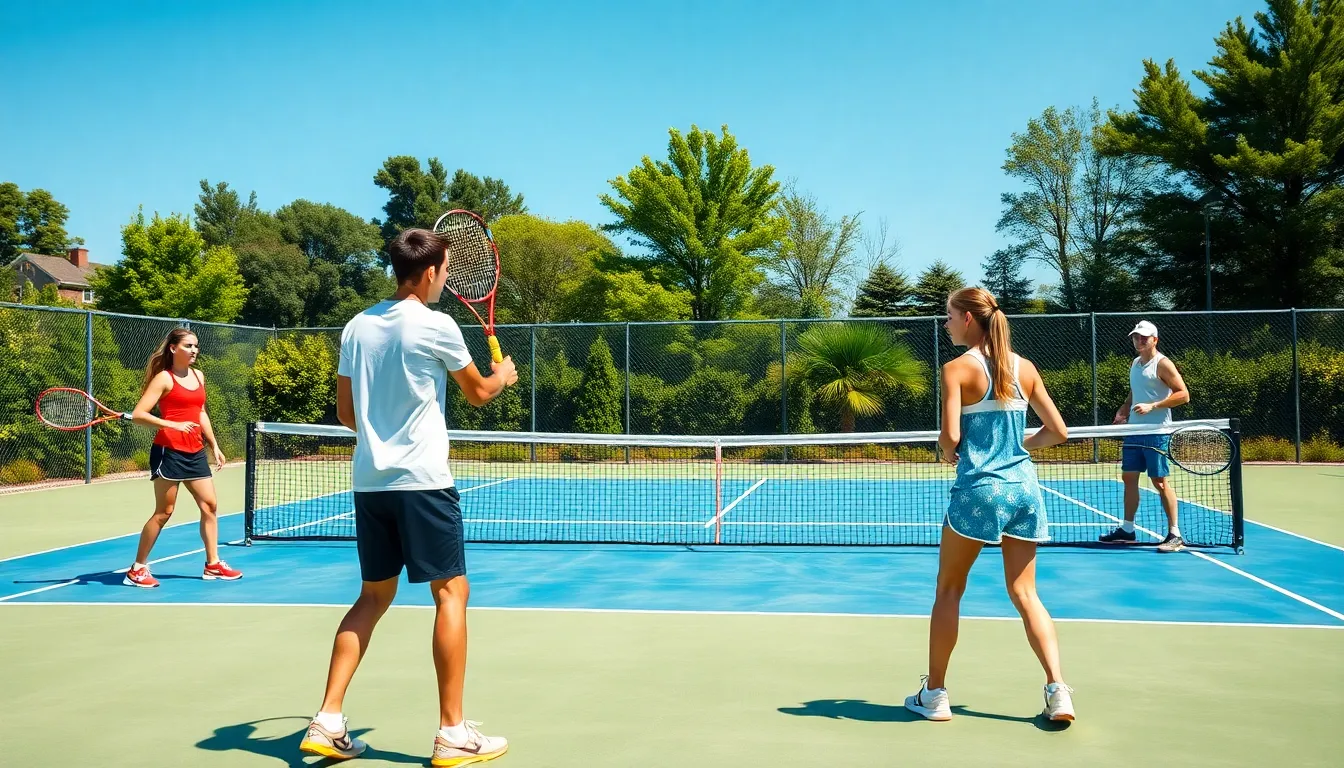
Tennis team competitions follow structured formats where you’ll participate in both individual and paired events. These competitions integrate various match types into a comprehensive scoring system that determines team victories.
Singles and Doubles Play
Singles and doubles matches form the core of tennis team competitions. In singles play, you’ll compete one-on-one against an opponent, showcasing your individual skills and strategy. Doubles matches pair you with a teammate to face another duo, requiring coordination and specialized tactics like poaching and formation shifts.
Junior team competitions typically follow a exact order—boys and girls doubles matches first, followed by singles matches, with mixed doubles often serving as the final contest. This structure provides opportunities for players with different strengths to contribute to the team’s success.
Team formats vary across age groups and organizations. High school matches generally include both singles and doubles components, while collegiate competitions maintain a consistent structure of six singles and three doubles matches. Tournament formats might incorporate additional categories like mixed doubles to provide diverse competitive experiences.
Team Scoring Systems
Team scoring systems differ based on the competition format and governing body. In collegiate tennis, the scoring works through a point accumulation system—winning two out of three doubles matches earns one point for your team, while each singles victory contributes an additional point. The first team to reach the designated threshold (typically four points) wins the overall match.
Team competitions use the standard tennis scoring progression of 15, 30, 40, and game within individual matches. Sets typically run to six games with a required two-game margin, though variations exist across different leagues and tournaments.
Before competitions begin, coaches submit official lineups detailing which players will participate in each match position. This strategic element requires careful consideration of player strengths, matchups, and recent performance. Once play begins, designated team representatives record scores and ensure matches proceed according to established rules.
Management responsibilities extend beyond the actual competition. Coaches coordinate practice schedules, secure court reservations, arrange transportation, and handle equipment needs. When weather or other circumstances interfere, they’re also responsible for rescheduling matches according to league regulations.
Team Roles and Responsibilities

Tennis teams function through clearly defined roles that contribute to the team’s success both on and off the court. Each position carries exact responsibilities that help maintain team structure, competitive edge, and positive dynamics throughout the season.
Player Responsibilities
Players form the core of any tennis team, with duties extending beyond simply showing up for matches. You’re expected to compete in assigned singles or doubles matches while maintaining proper preparation and focus. Supporting your teammates through encouragement and maintaining team spirit during matches creates a positive competitive environment. During matches, you’ll represent your team through both your performance and sportsmanship, setting the tone for the entire squad.
Captain Duties
Team captains serve as the bridge between coaches and players while modeling exemplary leadership. You’ll lead by example both on and off the court, demonstrating accountability and courage, particularly during challenging situations. Organizational responsibilities include submitting match lineups at least 15 minutes before matches and meeting with opposing captains to review ground rules.
Effective captains communicate regularly with players about availability while developing strategic match lineups that align with team philosophy – whether that means playing to win or ensuring inclusive participation. Your leadership role requires holding teammates accountable for preparation and effort while maintaining a caring approach by respecting all team members and managing conflicts privately. Preventing negative behaviors like gossip helps maintain team chemistry and creates a supportive environment where everyone can thrive.
Coach/Manager Responsibilities
Coaches and managers handle the administrative and technical aspects of team operations. Your responsibilities include checking in the team at match sites, managing scorecards, and ensuring accurate recording of match results. Enforcing league rules falls under your purview, including making sure all scheduled matches are played and avoiding forfeitures that could penalize the team.
As a coach or manager, you’ll serve as the liaison between the club and coaching staff to support compliance and resolve any issues that arise. Practical logistics management includes securing court availability, handling fees, and ensuring match equipment needs are met – from providing tennis balls to arranging transportation when necessary. Your guidance shapes both team strategy and individual player development through training plans and match preparation.
Supporting Your Teammates
Supporting teammates creates the foundation for a successful tennis team experience. You’ll build team cohesion by encouraging others during both practices and matches, celebrating successes, and providing support after disappointments. Effective communication helps resolve conflicts quickly and maintains a positive team environment where everyone feels valued.
Team members who excel at supporting others offer exact technical feedback rather than vague encouragement, recognize individual improvement, and maintain positivity even during challenging matches. Demonstrating leadership qualities motivates others around you and establishes high standards of dedication and sportsmanship. Small gestures like helping with equipment, staying to watch teammates’ matches, or organizing team bonding activities strengthen relationships beyond the court and create a team culture that fosters both individual growth and collective achievement.
Off-Court Team Activities
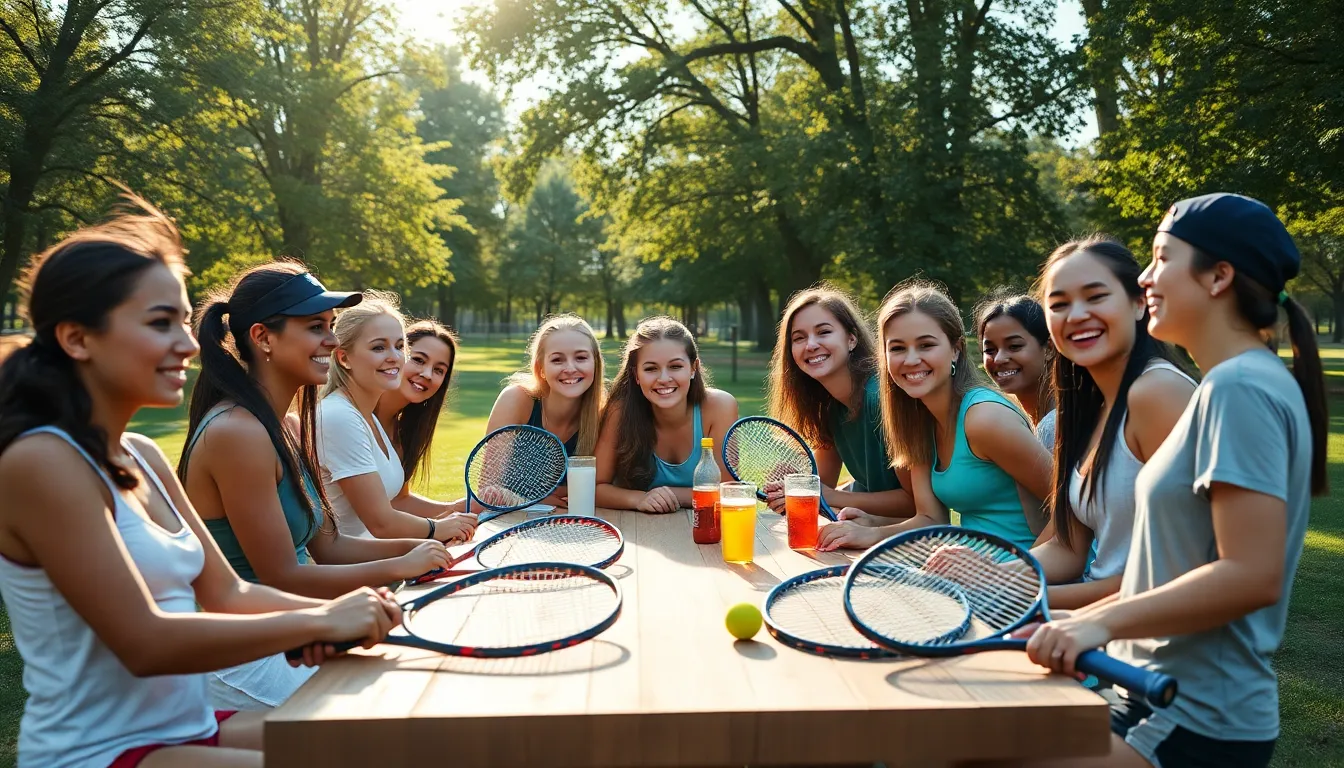
Tennis teams thrive beyond the court through activities that build relationships and contribute to the broader community. These off-court engagements create the foundation for a unified team culture and strengthen bonds among players with shared experiences.
Team Bonding Events
Team bonding events transform individual players into a cohesive unit through shared experiences outside competitive play. Social gatherings like team dinners create relaxed environments where teammates connect personally rather than just as fellow competitors. Many teams organize outings to professional tennis tournaments, providing both entertainment and educational opportunities as players observe high-level play together.
Coaches design exact team-building exercises that emphasize collaboration over individual performance. These activities help players of varying skill levels develop mutual respect and support systems that translate to better on-court chemistry. Fun competitive games incorporated into practice sessions—like the popular “PAC-MAN” drill—simultaneously build skills and positive relationships among teammates.
The most successful tennis teams prioritize these bonding experiences, recognizing that strong interpersonal connections lead to better communication during doubles matches and more enthusiastic support during individual play. Teams that bond effectively off-court typically demonstrate greater resilience during challenging match situations.
Fundraising and Community Service
Tennis teams actively engage in fundraising initiatives to support essential team expenses throughout the season. Common fundraising activities include hosting local tennis tournaments, organizing community clinics, and selling team merchandise. These efforts help cover costs for travel, equipment upgrades, and tournament registration fees that might otherwise burden individual players.
Community service projects extend a team’s impact beyond the tennis community. Teams frequently volunteer at local schools to introduce tennis to younger students, participate in environmental clean-up efforts, or support tennis programs for underprivileged youth. These activities enhance the team’s public image while providing players with valuable perspective on their privileged position as athletes.
Many collegiate and high school programs require participation in service projects as part of team membership, recognizing the dual benefit to both the community and team culture. Players who serve together develop deeper connections and appreciation for their teammates’ character and values outside competitive environments. The shared experience of giving back creates meaningful memories that strengthen team unity and purpose beyond winning matches.
Benefits of Joining a Tennis Team
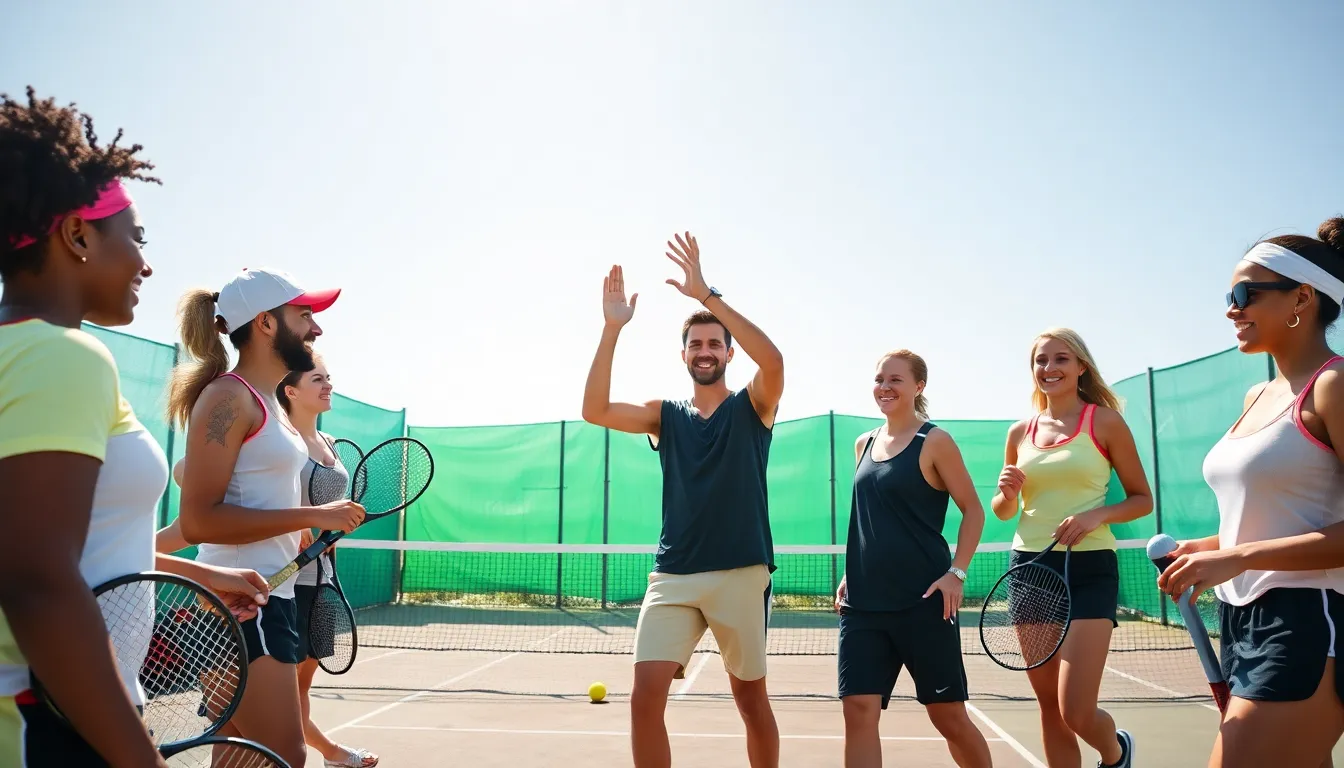
Tennis teams offer many advantages that extend far beyond simply playing matches. These benefits cover physical conditioning, mental resilience, and social connections that enhance your overall well-being and lifestyle.
Athletic Development
Joining a tennis team significantly improves your physical fitness through regular practice and competition. Your cardiovascular health, agility, coordination, and overall strength develop naturally as you participate in team training sessions and matches. Tennis demands quick movements and rapid responses, conditioning your body for both endurance and explosive power.
Tennis team participation also sharpens crucial mental skills that transfer to everyday life. You’ll develop mental toughness through competitive play, learning to maintain focus under pressure, formulate effective strategies, and make split-second decisions. These cognitive benefits extend beyond the court, improving your problem-solving abilities and emotional resilience in professional and personal situations.
Social and Personal Growth
Tennis teams create a unique social environment where you build meaningful connections while pursuing athletic excellence. Even though tennis often being viewed as an individual sport, team formats foster camaraderie, friendship, and collaboration among players who share your passion. You’ll experience a supportive community where teammates celebrate successes and help each other through challenges.
Your self-esteem and confidence naturally increase through team participation. The combination of skill development, competitive success, and group acceptance creates a powerful foundation for personal growth. Tennis teams promote discipline and commitment through structured practices and match schedules, teaching you to balance individual goals with team responsibilities.
The social engagement within tennis teams provides a support network that extends beyond practice sessions. Team members often become training partners, mentors, and friends who understand your tennis journey. This sense of belonging contributes to your overall well-being while creating lifelong social connections in a supportive athletic community.
Conclusion
Joining a tennis team offers you a groundbreaking experience that balances individual growth with team camaraderie. As you progress from high school to college competition you’ll develop not just technical skills but mental toughness that serves you well beyond the court.
The structured environment of practices challenge matches and formal competitions creates a merit-based system that constantly pushes you to improve. Through this journey you’ll build meaningful relationships with teammates while representing your school or club with pride.
The benefits extend far beyond tennis itself – enhanced physical fitness mental resilience social connections and lifelong friendships become part of your development. Whether you’re a beginner or experienced player a tennis team provides the perfect blend of personal achievement and collective success in a sport you can enjoy for life.
Frequently Asked Questions
What does being part of a tennis team involve?
Being part of a tennis team involves participating in singles and doubles matches, attending regular practices, and competing for your school, club, or community. Players develop technical skills like serves and volleys while building mental toughness and strategic thinking. The experience combines individual achievement with team camaraderie, creating a supportive environment among teammates who share a passion for tennis.
How are high school tennis teams structured?
High school tennis teams use a ladder ranking system to determine player positions, typically with 6-7 singles players and 3 doubles teams. Practices occur 4-5 days weekly with matches 1-3 times per week. Team captains motivate teammates and organize activities, while challenge matches allow players to improve their rankings throughout the season.
What’s different about college tennis compared to high school?
College tennis features more formalized competition with NCAA Division I teams having 8-10 players and Division III programs 12-14 players. Differences include no-ad scoring, higher equipment standards, and more sophisticated coaching with performance analytics. College teams often receive uniform equipment through sponsorships and travel extensively for tournaments and dual matches, reflecting a deeper commitment to the sport.
How do tennis team tryouts and selection work?
Tennis team tryouts establish player rankings through structured evaluations where coaches assess skills using pro-sets and round-robin tournaments. They evaluate technical proficiency, competitive spirit, and tactical awareness. Official ratings like UTR and NTRP provide objective measures for player comparisons. After assessment, players earn positions on a team ladder that can change throughout the season based on performance.
What are challenge matches in tennis teams?
Challenge matches allow players to contest their rankings on the team ladder, creating a merit-based environment. These matches occur during preseason as evaluation tools and continue throughout the regular season to maintain competitive intensity. This ongoing internal competition pushes everyone to maintain peak performance, creating growth opportunities and fostering healthy competition among teammates.
What happens during tennis team practices?
Team practices feature structured training that builds individual skills and team cohesion through targeted drills and simulated match scenarios. Sessions focus on refining stroke mechanics, doubles strategy, and developing comprehensive skill sets. Physical conditioning programs incorporate strength training, cardiovascular fitness, agility drills, and tennis-specific movements to enhance performance and prepare players for competitive matches.
How are tennis team competitions formatted?
Tennis team competitions include both individual and paired events, with singles and doubles matches as the core components. Junior formats typically feature boys and girls doubles followed by singles, with mixed doubles often concluding. Collegiate tennis uses a point system where winning two out of three doubles matches earns one point, and each singles victory adds another point.
What roles exist within a tennis team?
Tennis teams have defined roles including players who compete in assigned matches and support teammates, team captains who bridge the gap between coaches and players while managing match logistics, and coaches who handle administrative tasks and player development. Supporting teammates through effective communication and encouragement is emphasized for building team cohesion.
What team activities happen off the court?
Off-court activities include team bonding events like social gatherings and trips to professional tournaments, team-building exercises that promote collaboration, and community service projects. These activities strengthen team culture, enhance on-court chemistry, and support team expenses. Shared experiences develop deeper connections among teammates, reinforcing that successful teams thrive both on and off the court.
What are the benefits of joining a tennis team?
Joining a tennis team enhances physical fitness by improving cardiovascular health, agility, coordination, and strength. It builds mental resilience, teaching focus under pressure and quick decision-making. Socially, it creates a supportive community where players form meaningful connections that boost confidence. The structured environment promotes discipline while providing a lasting support network that contributes to overall well-being and personal growth.


